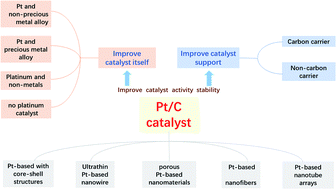Current progress and performance improvement of Pt/C catalysts for fuel cells
Abstract
The fuel cell is an electrochemical device that can directly convert the chemical energy of fuels into electrical energy through a chemical reaction at the interface of the electrode and the electrolyte, without going through the heat engine process, and is not limited by the Carnot cycle, so the energy conversion efficiency is high without noise and pollution. Among them, the proton exchange membrane fuel cell (PEMFC) is a promising power source for electric vehicles and stationary residential applications. However, current PEMFCs have several problems that need to be solved, including high cost, insufficient power density, and limited performance durability. Therefore, to achieve large-scale application of PEMFCs, the development of advanced Pt-based catalysts is very important to solve these problems. For the requirement of high activity and high stability for Pt-based catalysts, the current progress and performance improvement of Pt/C catalysts for fuel cells are summarized in this review. Furthermore, the review focuses on improving performance and proposes the development direction of Pt/C catalysts in these fuel cells in the future and the main challenges in the actual process. To improve the performance of Pt/C catalysts, reducing the diameter of Pt particles, preparing Pt particles with a specific orientation surface, and alloying Pt with transition metals are approaches for the improvement of Pt catalysts. Furthermore, the performance of carriers significantly influences the performance of Pt/C catalysts.

- This article is part of the themed collection: Journal of Materials Chemistry A Recent Review Articles


 Please wait while we load your content...
Please wait while we load your content...